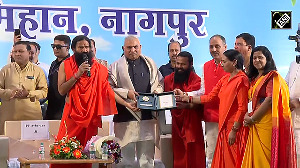A Chicago-based paleontologist has discovered a new species of dinosaur -- Rajasaurus narmadensis -- after analysing the bones unearthed from central and western parts of India.
Paul Sereno, along with his team, also reconstructed the dinosaur skull based on the bones collected by Indian paleontologists over the past several years.
Disclosing the find at a media conference on Wednesday in Mumbai, Paul, a National Geographic explorer, said the new species was a unique dinosaur found only in India so far.
"The new species named Rajasaurus appears to be a stocky dinosaur with an unusual head crest. From the heavy weight of the hip bone we have concluded that the dinosaur was probably a heavy-meat-eating carnivorous animal," said Paul.
The 30-feet-long dinosaur with its unusually long horn and a strong exterior face suggests that it used its head to pound its prey and eat it. However, its teeth, ironically are much smaller than those found in other dinosaurs.
Believed to be 67-million year old, the Rajasaurus perhaps appeared towards the extreme end of the era of dinosaurs and would have moved through the entire Narmada valley, before the emergence of the Himalayas on the Indian subcontinent, he said.
"We decided to name the animal Rajasaurus narmadensis, which means regal reptile from Narmada since the bones were found near the Narmada river in western India," he explains.
Rajasaurus appears to be related to the species found in Africa, Madagascar and South America.
Recounting the background of the historical find, Paul, said that he along with his team had arrived in India in January 2001 to study the fossil bones of dinosaurs discovered from a pit of skeletal debris found at a regional geological survey in Jaipur in 1980s.
"After a detailed study of a map prepared of the Jaipur fossil, we also spent nearly two months in Raoli village in Gujarat trying to trace some more fossil bones. Our search yielded some results. We were able to find the central part of the skull, left and right hip bones and a sacrum during our two month stay," he said.
A vexing problem, was the presence of bones of both the meat-eating dinosaur (theropods) and plant-eating dinosaur (sauropods).
"The presence of bones of both kinds makes it difficult to reconstruct an animal. However, it was a detailed map drawn by Indian paleontologist Srivastava in 1983, documenting the position of each fossil bone as it lay in the rock that was the key to reconstructing the skull," he said.
"We got a marker and began colouring each bone on the map. As we sat there all dirty on the floor, we suddenly realised that a partial skeleton of a meat-eater lay there. We could see one individual dinosaur," he said.
With the help of the bones from Jaipur, the bones found by Paul's team and earlier bones found in Jabalpur the team was able to reconstruct the skull, he said.
"The discovery, which will be put for examination before global experts, was important since it would help in adding to the current knowledge of dinosaur belonging to the family of Abelisaur predators and adding a new angle to dinosaur in the Indian subcontinent," he said.






 © 2025
© 2025